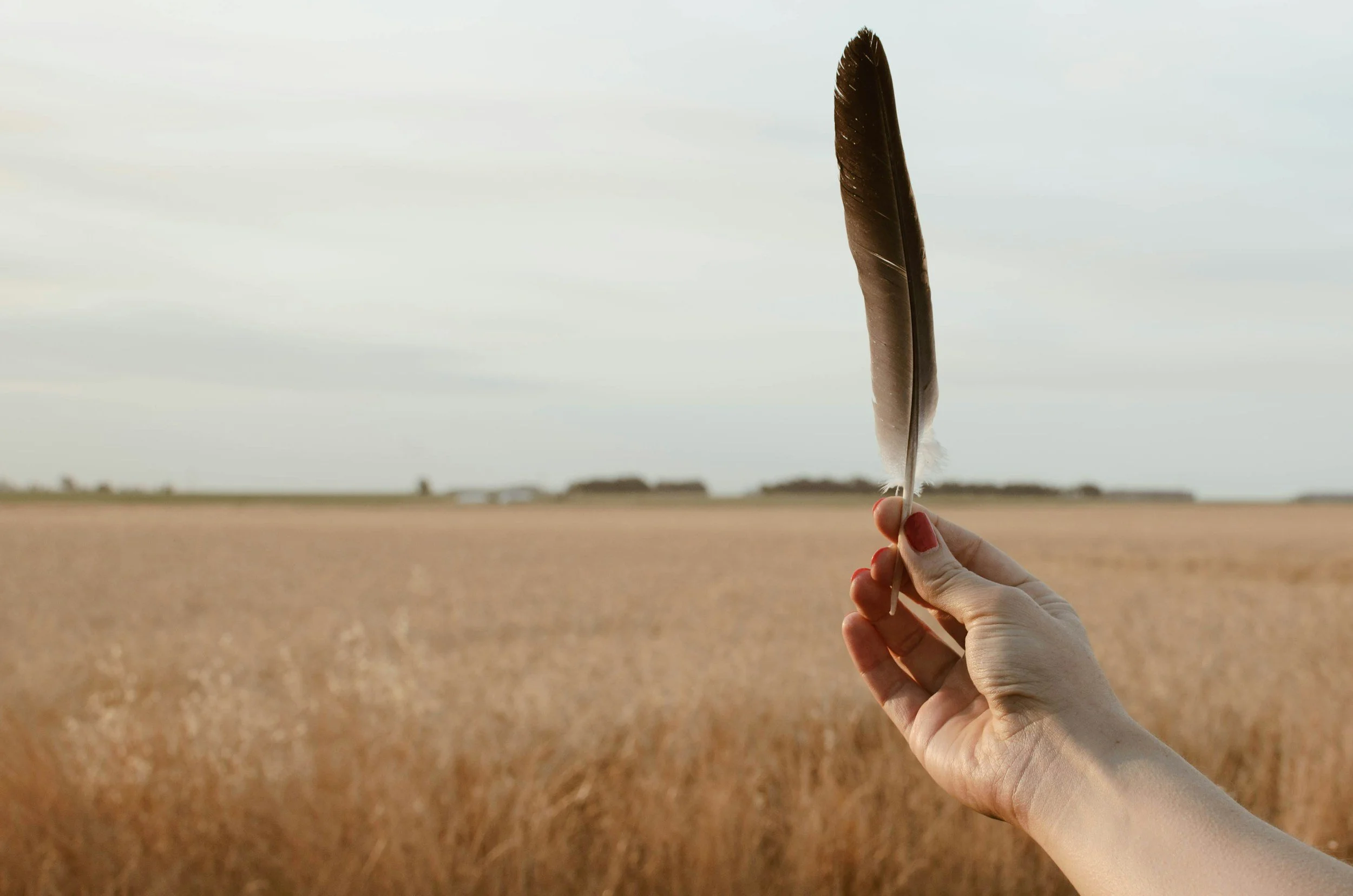How to Let Go of Grief Without Letting Go of Love: 2 Lists That Help You Release the Pain You Carry
Grief can make reading hard. Want to listen to this article instead? Find its corresponding podcast episode here.
The phrase “Just let it go!” can feel infuriating when you’re grieving.
It’s one of those grief clichés that’s allegedly well-meaning but actually deeply dismissive and hurtful. You're told to let go of the pain, to move on, or to leave the past behind, as if grief is something you can simply drop and walk away from like it never mattered.
So what does it really mean to “let go” after loss?
And is it even possible without also letting go of your memories, your identity, your person?
The truth is, letting go isn’t about forgetting. It’s not about pretending you’re “over it.” And it’s definitely not about leaving your loved one—or your grief—behind.
Letting go is about releasing the pain you carry, bit by bit.
Letting go is about loosening your grip on the weight of what can no longer be—what loss took away from you.
And letting go is about making space for where you’re going, without erasing where you came from.
If you’re hoping to learn more about letting go or releasing the pain of life after loss, that’s where two of my favorite lists come in.
“Letting Go” vs. “Releasing”: Why Language Matters in Grief
You may already feel resistant to the phrase “let go”—and for good reason.
It’s vague. It sounds final. And it’s often said by people who don’t understand what it means to live life alongside grief—people who think it’s possible to leave grief in the past like an outgrown toy or a pair of pants that no longer fit.
If you’re feeling a pressure to leave grief “back there,” you might consider shifting the order to “let it go” into an invitation to “release what you can.”
Here’s an excerpt from my daily guidebook Your Grief, Your Way that speaks to this:
“Well-meaning friends and family will tell you to ‘just let it go,’ but how can you? It seems impossible to just let go of the pain, the heartache, or the memories of your loved one. So, instead of ‘let it go,’ try using ‘release.’ Release comes from the Latin word relaxare, which means ‘to loosen, to free from confinement and obligation’—and that can feel much clearer than ‘just let it go.’ Ask yourself what you would like to loosen and free from confinement and obligation. Maybe you want to release the thoughts of your loved one’s final moments. Perhaps you want to release the obligation to chair your neighborhood’s block party this year. When you feel like you’re holding on too tight, finish this sentence: ‘Right now, I would like to release [insert thing to be released].’”
This type of releasing work is exactly what we do in Module 2: Release inside Life After Loss Academy. For me and for the students I teach, “letting go” after a loss is not about erasing grief. It’s about choosing—again and again—what you’re ready to loosen your grip on.
It doesn’t look like releasing all of grief, and certainly not all at once. It’s just one thing at a time; one thing you choose for yourself.
So let’s talk about how to do that, starting with two simple but powerful lists.
List #1: The Identity List—Letting Go of the Person You Used to Be
Regardless of the type of loss you faced—death, divorce, diagnosis, or something else—grief goes way beyond mourning the person or thing that you lost. It also includes grieving identities, roles, and parts of yourself.
These are often roles that loss stole or invalidated. For instance, you may grieve your role as a caregiver after the person you were caring for dies. You might also grieve your status as a healthy or able-bodied person after a life-changing diagnosis.
Other less-acknowledged roles are emotional, logistical, spiritual, or functional. For example, you might grieve being perceived as “the strong one” in your family, the planner in your friend group, or the productive employee at your job. Even more abstract identities include things like safe, innocent, protected, and known.
One of the weird identities I grieved after my mom’s death in 2013 was “morning person.” The exhaustion of grief made me want to sleep all the time—and that included sleeping in. While this may not feel like a big deal to others, it really messed with my sense of identity. After all, I’d gotten up with the sun whether I liked it or not for 21 years. Who was this stranger who could snooze until noon? I didn’t recognize her, yet here she was taking up space in my body. And that freaked me out.
When my best friend, Tami, died in 2022, I grieved my identity as someone training for the Chicago Marathon. I was diagnosed with a chronic illness around the same time and it was strongly recommended that I discontinue any intensive training immediately. The last long run I took was one I took with Tami—and I haven’t run another since.
Like many grievers, I was not only grieving my mom and my best friend; I was also grieving the person I used to be.
The Identity List helps you name who you no longer are, so you can begin to release the pressure to keep performing those roles. It also helps you wrap language around some part of you that may be missing but you haven’t put words to yet.
Try this:
Write down all the roles, titles, or ways of being that are no longer available to you because of your loss.
These might include:
Spouse or partner of a living person
Parent of a living child
Married person
Caregiver
The productive employee
The social butterfly
The quick thinker
Morning person
Marathon runner
Safe
Innocent
Protected
Known
Now, ask yourself, “How might I ritualize and release this identity—or say goodbye to this version of me—in a way that feels meaningful to me?”
For instance, I might grieve my identity as a marathon runner by leaving a special rock at one of mine and Tami’s favorite running destinations. I might box up and say goodbye to my running gear, donating it to someone who can use it. I might light a candle and write a letter to my body, reliving our running memories and sending it care and good health as it is now. There are truly countless ways to release an identity.
And if your identity list is overwhelming to you, it’s okay. It’s very normal to see the enormity of what can no longer be and get overwhelmed. If you find yourself in that headspace, take a break and put your list away for a while. Just making the list is a powerful first step. You can decide on your releasing rituals later.
And of course if you want help inventing releasing rituals—especially the more abstract ones—you can join us at any time in Life After Loss Academy.
List #2: The Hopes, Dreams, and Expectations List—Letting Go of What Can Never Be
When it comes to grieving after a loss, we know to mourn the person or thing that is missing—or the irreversible event that happened. But we are rarely given space, permission, validation, or instruction when it comes to grieving the future.
These are the hopes, dreams, and expectations you thought would happen, but that are now impossible because of loss. For many of my clients and students, this includes vacations that will never be taken, retirement that will never be shared, children that will never be raised, and milestones that will never be celebrated together.
These invisible losses of future hopes and plans are just as real—and just as devastating—as the loss itself. And naming them can feel, to put it mildly, like a big huge bummer on top of an already big huge bummer. The bummer icing on the bummer cake, so to speak.
Longtime followers of my work know that one of the biggest hopes I grieved after my mom’s death is the hope of reconciliation. She and I were in the middle of a fight about my sexuality when she died (my identity clashed with her religious beliefs) and we never came to an understanding while she was still on earth.
Another vivid example I have of grieving a future expectation is when the person I was engaged to suddenly ended our relationship. Overnight, I went from engaged to single, and my plans for moving to be together crashed and burned. I had to scramble to find a job and talk my landlord into letting me resign my lease when I’d agreed to move out months earlier. I mourned not only the relationship that was supposed to be but the life we were supposed to have together.
So, so many grievers are carrying around emotions like disappointment, heartache, and hopelessness. It can be comforting in a way to recognize that often times, they are tied to unnamed dreams and expectations that loss took away.
The Hopes, Dreams, and Expectations List is where you name what can no longer happen so you can start finding meaning in what still can.
Try this:
Write down the dreams you had for the future—big or small—that are no longer possible.
This might include:
Growing old together
Watching your child graduate
Becoming a grandparent
Retiring and traveling
Reconciling with someone who’s now gone
Seeing someone heal
Being someone who never experienced loss
Now, ask yourself, “How might I ritualize and release these hopes, dreams, and expectations in a way that feels meaningful to me?”
One of my favorite examples of releasing after a breakup was one I learned from Tami in college. After one of our mutual friends got dumped by a guy we all thought was mean to her, a big group of women went to the local thrift store and bought a bunch of cheap ceramic plates. They used Sharpie markers to write their relationship’s worst qualities on the plates. Then they drove to a nearby mountain and tossed the plates off the side of the mountain—of course, in a way where they wouldn’t land on anyone. While I can’t speak to the environmental friendliness of this ritual, I can tell you everyone came back feeling like they’d released something.
Other examples of releasing rituals for a future that can no longer be might include things like writing on wish paper and safely setting it on fire, releasing butterflies or lanterns, planting seeds and watching them grow, writing a song or making a piece of art, or relocating physical objects (such as an ex’s dusty couch or a wedding dress you’ll never wear) somewhere new. One Life After Loss Academy student released her future hopes surrounding her daughter who died by floating leaves down a river behind her home. As you can see, there are limitless ways to ritualize and release plans and dreams that loss rendered impossible.
And again, if your hopes and expectations list is overwhelming, it’s okay. Recognizing and absorbing the full picture of a future that can no longer be can be incredibly painful. Pause and set down your list for a bit. Validate, even if just to yourself, that making the list in the first place is a powerful step towards healing. You can decide on your releasing rituals another time.
And of course if you want help naming what you’re releasing or creating rituals to let go, join us inside Life After Loss Academy.
Why These Two Lists Matter
Notice that in both of the lists above, I made zero mention of letting go of love.
Each list—the Identity List and the Hopes, Dreams, and Expectations List—asks you to name specifically what it is you are releasing. And I want to be crystal clear here: if there is love in the relationship, object, season, or transition you are grieving, you get to keep it.
This is the gift of shifting from “letting go” to releasing!
My mission as a grief coach is not to draw grief out of you and tie it to a post somewhere “back there” so you can walk on, free and unburdened into a painless future. That’s not an authentic way to live, and it totally negates everything you’ve been through that’s gotten you to this point.
My goal in inviting you to make these two lists is to help you identify exactly what you’ve lost, so you know what you need to grieve and release—but also so you know what still gets to come with you as you move forward.
When you write down the things that you’ve lost, whether visible or invisible, you start to process them. You start to soften around them and shake them loose from your already-heavy arms. You start to let go of identities and futures that have died… while continuing to carry as much of the love, memories, and care as you want.
These lists don’t erase the pain; they just give the pain somewhere to go.
And that’s how releasing or “letting go” of grief works. It’s not a one-and-done exercise. It’s not a switch you flip. It’s a lifelong practice of checking in with yourself and asking: “What am I still carrying that loss made untrue? What can be loosened, set down, or freed from confinement? What am I holding onto that wants to rest?”
You have the power to name it and decide how you would uniquely like to ritualize and release it.
Closing Thoughts: “Letting Go” Is a Practice, Not a One-Time Thing
Here’s what I need you to know: you don’t “let go” once. You don’t make a list and feel instantly better.
You practice. You write and rewrite. You experiment with different rituals to see what feels best to you. You sleep on it. You ask for help from ancestors, guides, and mentors. You release in one way one season and a totally different way in another. You do it again and again, whenever your heart tells you it's time.
In Life After Loss Academy, we don’t avoid the work of releasing—we embrace it, gently and with ongoing support.
Inside Module 2: Release, I walk you step-by-step through how to complete both of these lists with care, clarity, and community. You’ll learn how to ritualize the act of release, how to express your grief safely, and how to gently soften into a future that includes your losses—but is no longer defined by what and who they took from you.
If you're ready to feel a little lighter, a little more grounded, and a lot more empowered, this is your invitation to begin.
Come join us inside Life After Loss Academy. Let’s release some of what you’ve been carrying—together.


